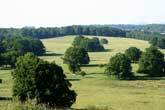- England
- Scotland
- France
- Holland
- Germany
- Italy
- Spain
- Portugal
- USA
- China
- Japan
- India
- Iran
- Advice
- Gardens
- England
- Scotland
- France
- Holland
- Germany
- Italy
- Spain
- Portugal
- USA
- China
- Japan
- India
- Iran
- Advice
- Garden Tours
Book: Landscape Planning and Environmental Impact Design: from EIA to EID
Chapter: Chapter 8 Forest design, forestry and sylviculture
Historically, forest management was less single-minded. There are lessons for Britain to learn from overseas and for other countries to learn from Britain's 60ï¾year dialogue between the forest industry and amenity groups. Britain is in a peculiar position with regard to tree cover and timber production. High forest is the climax vegetation for most of the country but, with only 1% of the world's population, Britain has to buy about 15% of all timber sold on world markets, because it produces only 15% of its own timber. About 10% of Britain's land area is under forest, compared with a European and American average of 32% (Crawford 1982). This is what happens to an old industrial country. The figures indicate there may be a need to enlarge Britain's forest estate ï¾ but an overï¾emphasis of wood production continues to arouse public opposition. In the seventeenth, eighteenth and nineteenth centuries, wood production was one among several objectives. Britain's great landowners certainly hoped for timber and profit but they also strove to improve the scenery, to shelter their farms, to provide cover for game, to make attractive walks and drives, and to create value for their descendants. Sir Walter Scott, who was an enthusiastic tree planter and landscape designer on his own estate [Fig 8.5], wrote that 'when ye hae naething else to do, ye may be ay sticking in a tree, it will be growing, Jock, when ye're sleeping' (Scott, 1818). The link between forestry and landscape design flourished because most foresters then started out as gardeners. James Brown, originally a gardener, wrote the most successful nineteenth century book on forestry and became first president of the Royal Scottish Forestry Society. Brown believed that 'It is admitted by every person of refined taste, that no object is so ornamental upon a landed estate as an extensive healthy plantation, situated upon a wellï¾chosen spot and having a wellï¾defined tastefully bending outline....no man ought to attempt the laying out of land for one who is not naturally possessed of good taste for that sort of landscape scenery which is based upon the laws of nature' (Brown 1882: 73). Brown advised that a man should plant trees 'to give shelter to his farms, to shut out some unpleasant object from his dwellingï¾house, or to produce ornamental effect to the landscape, but the great and ultimate object is that of being profitable as a crop' (Brown 1882: 73). Brown's approach now seems wiser than that of his successors, who criticised him. By 1900 British foresters were looking to France and Germany and seeing that forests could be run on more scientific lines than was customary in Britain. Simpson, who wrote on The New Forestry in 1900, assailed Brown for aiming at the production of large and beautifully grown trees, instead of the maximum timber crop (Simpson 1900: 37). Others suggested that Brown's method was 'simply the gardener's plan of growing trees for ornamental purpose carried to the woods' (Simpson 1900: 199). Simpson himself disagreed with this opinion and said that 'The only men fitted to engage in scientific forestry at present are those who have had a gardener's education to begin with' (Simpson 1900: 35). Nisbet, who also published a book on forestry in 1900, was critical of nonï¾timber objectives. He believed that Britain could become selfï¾sufficient in timber if 'our present three million acres of woodlands were trebled in extent, and were all managed on business principles, in place of being under uneconomic management as game coverts and pleasure grounds, as is now mostly the case with British forests' (Nisbet 1900: 83). The consequences of depending on imported timber became apparent during the 1914ï¾18 war: imports were restricted and there was an acute shortage of wood for pit props, trench-building and other purposes. Between 1913 and 1918, the volume of wood imports fell to 25% of the preï¾war level and the price of wood rose by 400% (Forestry Commission 1920: 21). Britain's private woodlands were ransacked for extra timber. In 1918 a forestry committee, chaired by Sir Francis Acland, identified a need for state forestry. The committee reported that 'the condition of our woods has been greatly influenced, in England and Ireland at least, by sporting and aesthetic considerations. Mixed open woods with good game cover have been preferred to dense cleanï¾grown woods, with consequent loss in the quantity and quality of the timber produced' (Sub-committee on forestry 1918). The Acland committee therefore recommended a strictly scientific approach to forestry in order to achieve 'maximum efficiency of production' ï¾ though he was absolutely correct in predicting that 'the hope of direct profit is very remote' (Sub-committee on forestry 1918). The government accepted the Acland report and established the Forestry Commission in 1919. The Commissioners were charged by the Forestry Act with 'the general duty of promoting the interests of forestry, the development of afforestation, and the production and supply of timber' (Forestry Act 1919). There was nothing in the Act about aesthetics, sport, wild life, wild food, rural employment, sheltering farms, or recreation. So the Commissioners and their employees were not empowered to take action on these matters.
